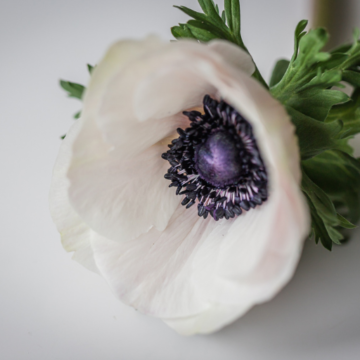When we delve into the world of flowers, anemones stand out as one of the most intriguing and beguiling blooms. These delicate wonders belong to the Ranunculaceae family and have a rich history deeply intertwined with culture, art and healing practices.
Anemones have been treasured for centuries, and their name is derived from the Greek word “anemos,” which means wind. In Greek mythology, it is said that the Anemoi, the wind gods, sprang forth from the first anemone flowers.
Throughout history, these flowers have held various cultural significances. In ancient China, they symbolised enduring love and were often used in wedding ceremonies. In contrast, in ancient Egypt, they were linked to mourning and farewells.

One renowned artist who had a fascination with anemones was the celebrated French painter Claude Monet. His series of paintings featuring anemones showcased his deep appreciation for their vibrant colors and delicate petals. https://www.christies.com/en/lot/lot-5553446
In the Victorian era, flowers were used to convey emotions and sentiments through a coded language known as “floriography.” Anemones represented anticipation and the eagerness for something new and promising on the horizon.
In contemporary times, anemones continue to symbolise anticipation and are often given as tokens of excitement for future endeavors or events.
In traditional medicine, anemones were utilised for their healing properties. The root of certain species, like the wood anemone (Anemone nemorosa), was employed in herbal remedies to treat various ailments, including headaches and cramps. https://www.botanical-online.com/en/medicinal-plants/anemome-nemorosa-toxicity

Modern medicine has not extensively explored the therapeutic potential of anemones, but their historical use in traditional medicine suggests they may have some medicinal value.
Aside from their scientific name, anemones have several common names, such as windflower and thimbleweed. These names reflect their ethereal and airy appearance.
Anemones are typically grown from bulbs and thrive in well-drained soil with partial to full sunlight. They are planted in the autumn and bloom in the spring. To ensure a continuous display of flowers, staggered plantings throughout the autumn season are recommended.
For harvesting, anemones should be picked when the buds are just beginning to open, but before they fully bloom. This stage ensures the longest vase life and the preservation of their vibrant colors.

While there are many common varieties of anemones, some rare and exotic species exist. The “Pulsatilla” or “Pasqueflower” is one such rarity, known for its feathery, soft petals and striking appearance. https://en.wikipedia.org/wiki/Anemone_occidentalis
Anemones have a good vase life, lasting up to a week or more with proper care. To keep them fresh, trim the stems at an angle, change the water every few days, and remove any wilted or yellowing leaves.
Anemones are not just stunning flowers; they symbolise anticipation, offer potential healing properties, and highlight the enduring connection between nature, culture and human creativity. Whether they grace your garden or adorn a vase on your table, anemones are sure to add a touch of beauty and wonder to your life.
Learn how you can benefit from the therapeutic benefits of flowers – FLOWER THERAPY




